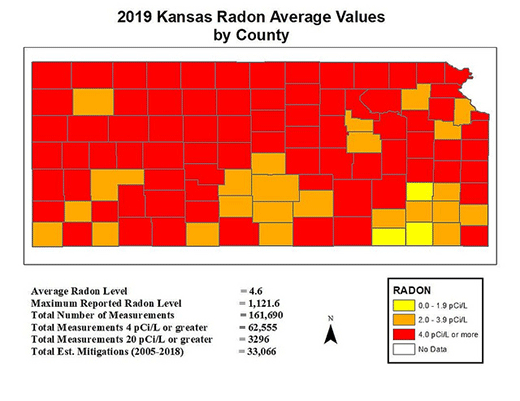
Radon, a colorless, odorless gas produced naturally in some soils is prevalent in Kansas. It's the leading cause of lung cancer deaths in non-smokers. | Download this photo.
Odorless, colorless radon gas is prevalent in Kansas; have your home checked
January is National Radon Action Month
December 18, 2018
MANHATTAN, Kan. – Location, location, location – Kansas is fortunate to have the scenic Flint Hills, a relatively low cost of living, and produces a valuable part of our food supply.
On the downside, there’s a decent chance your home will test positive for radon, an odorless, colorless gas that is the leading cause of lung cancer in non-smokers.
“One in four homes in Kansas will test at or above the EPA’s radon action level,” said Bruce Snead, director of the Kansas Radon Program at Kansas State University. He referred to the Environmental Protection Agency’s radon action level of 4.0 picocuries of radon per liter of indoor air.
To help raise awareness and encourage people to have their homes tested, the EPA has deemed January National Radon Action Month. Kansas Gov. Jeff Colyer signed a proclamation Dec. 18 recognizing the month in the state.
Radon occurs naturally in the soil. Its levels are low outdoors because its effects are diluted, but indoor levels can build and lead to lung cancer. And Kansas soils generate significant amounts of radon leading to the potential for homes to have elevated concentrations of this naturally-occurring class A carcinogen.
Snead encourages all homeowners to test for radon. Test kits can be obtained from many K-State Research and Extension offices for a reduced fee, which includes a lab analysis and return postage. Kits can also be ordered online at www.sosradon.org at retail price.
More than 112,000 radon measurements have been reported in Kansas, according to the Kansas Department of Health and Environment. The agency indicates that the statewide average indoor radon level in Kansas is 4.9 picocuries of radon per liter (pCi/L), which is above the EPA threshold of 4.0.
For homeowners who test and find elevated radon levels in their homes, the most common technique to reduce it is called Active Soil Depressurization. An ASD mitigation system is a permanently-installed pipe-and-fan system that places a direct constant vacuum on the soil beneath the home’s foundation, so the amount of radon that can penetrate into the living space is reduced.
More information about radon, testing and mitigation is available at kansasradonprogram.org/home or by calling the Kansas Radon Hotline at 1-800-693-5343.

